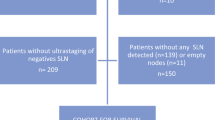Abstract
Purpose
To analyze the relationship between the size of metastatic sentinel lymph nodes (SLNs) and the risk of non-sentinel lymph node (non-SLN) metastasis in endometrial cancer.
Patients and Methods
From a total of 328 patients with endometrial cancer who underwent SLN mapping from January 2013 to April 2019, 142 patients also underwent systematic completion pelvic ± paraaortic node dissections, and they form the basis of this study. The SLNs were examined by immunohistochemistry (IHC) when the hematoxylin–eosin stain was negative.
Results
The median age was 60 years. The overall detection rate for SLNs was 87.5%, and bilateral SLNs were observed in 66.2%, with a median of 2 SLNs resected (range 1–8). Twenty-nine (20.4%) cases had positive SLNs, with a median of one positive SLN. Regarding the size of SLN metastasis, 5 (3.5%) cases had isolated tumor cells (ITCs), 13 (9.2%) had micrometastases, and 11 (7.7%) had macrometastases. Notably, 14/29 (48.3%) had node metastases that were detected after IHC. Eight (27.6%) patients had positive non-SLNs, with a median count of 7 positive nodes (range 2–23). Regarding the size of SLN metastasis, non-SLN involvement was not present in cases with ITC (0/5) but was present in 15.4% (2/13) of cases with micrometastases and 54.5% (6/11) of cases with macrometastases. The only risk factor for positive non-SLNs was the size of SLN metastasis.
Conclusions
Our data suggest that size of SLN metastasis is associated with the risk of non-SLN metastasis. No patients with ITCs in SLNs had another metastatic lymph node in this study.
Similar content being viewed by others
References
Bogani G, Murgia F, Ditto A, et al. Sentinel node mapping vs. lymphadenectomy in endometrial cancer: a systematic review and meta-analysis. Gynecol Oncol. 2019;153(3):676–83.
Cormier B, Rozenholc AT, Gotlieb W, et al. Communities of Practice (CoP) Group of Society of Gynecologic Oncology of Canada (GOC). Sentinel lymph node procedure in endometrial cancer: a systematic review and proposal for standardization of future research. Gynecol Oncol. 2015;138(2):478–85.
Baiocchi G, Mantoan H, Kumagai LY, et al. The impact of sentinel node-mapping in staging high-risk endometrial cancer. Ann Surg Oncol. 2017;24(13):3981–7.
National Comprehensive Cancer Network, NCCN clinical practice guidelines in oncology: uterine neoplasms, Version 3.2019, 2019.
Kim CH, Soslow RA, Park KJ, et al. Pathologic ultrastaging improves micrometastasis detection in sentinel lymph nodes during endometrial cancer staging. Int J Gynecol Cancer. 2013;23(5):964–70.
Holloway RW, Gupta S, Stavitzski NM, et al. Sentinel lymph node mapping with staging lymphadenectomy for patients with endometrial cancer increases the detection of metastasis. Gynecol Oncol. 2016;141(2):206–10.
Soliman PT, Westin SN, Dioun S, et al. A prospective validation study of sentinel lymph node mapping for high-risk endometrial cancer. Gynecol Oncol. 2017;146(2):234–9.
Benedetti Panici P, Basile S, Maneschi F, et al. Systematic pelvic lymphadenectomy vs. no lymphadenectomy in early-stage endometrial carcinoma: randomized clinical trial. J Natl Cancer Inst 2008;100:1707–16.
Kitchener H, Swart AM, Qian Q, et al. Efficacy of systematic pelvic lymphadenectomy in endometrial cancer (MRC ASTEC trial): a randomised study. Lancet 2009;373:125–36.
Schiavone MB, Zivanovic O, Zhou Q, et al. Survival of patients with uterine carcinosarcoma undergoing sentinel lymph node mapping. Ann Surg Oncol. 2016;23(1):196–202.
Schiavone MB, Scelzo C, Straight C, et al. Survival of patients with serous uterine carcinoma undergoing sentinel lymph node mapping. Ann Surg Oncol. 2017;24(7):1965–71.
Ducie JA, Eriksson AGZ, Ali N, et al. Comparison of a sentinel lymph node mapping algorithm and comprehensive lymphadenectomy in the detection of stage IIIC endometrial carcinoma at higher risk for nodal disease. Gynecol Oncol. 2017;147(3):541–8.
Aloisi A, Casanova JM, Tseng JH, et al. Patterns of first recurrence of stage IIIC1 endometrial cancer with no paraaortic nodal assessment. Gynecol Oncol. 2018;151(3):395–400.
Touhami O, Trinh XB, Gregoire J, et al. Predictors of non-sentinel lymph node (non-SLN) metastasis in patients with sentinel lymph node (SLN) metastasis in endometrial cancer. Gynecol Oncol. 2015;138(1):41–5.
Ballester M, Dubernard G, Bats AS, et al. Comparison of diagnostic accuracy of frozen section with imprint cytology for intraoperative examination of sentinel lymph node in early-stage endometrial cancer: results of Senti-Endo study. Ann Surg Oncol. 2012;19(11):3515–21.
Monterossi G, Buca D, Dinoi G, et al. Intra-operative assessment of sentinel lymph node status by one-step nucleic acid amplification assay (OSNA) in early endometrial cancer: a prospective study. Int J Gynecol Cancer. 2019;29(6):1016–20.
Kennard JA, Stephens AJ, Ahmad S, et al. Sentinel lymph nodes (SLN) in endometrial cancer: The relationship between primary tumor histology, SLN metastasis size, and non-sentinel node metastasis. Gynecol Oncol. 2019;154(1):53–9.
Matei D, Filiaci V, Randall ME, et al. Adjuvant chemotherapy plus radiation for locally advanced endometrial cancer. N Engl J Med. 2019;380(24):2317–26.
Author information
Authors and Affiliations
Contributions
Study concept and design: GB, HM, LBF; data acquisition: CCF, GB, HM, BTG; quality control of data: GB, LYK, LDB, BTG; data analysis and interpretation: GB, LDB, LBF; statistical analysis: GB; manuscript preparation and editing: GB, HM, LYK, AABAC; manuscript review: all authors.
Corresponding author
Ethics declarations
Disclosures
The authors declare no conflicts of interest.
Additional information
Publisher's Note
Springer Nature remains neutral with regard to jurisdictional claims in published maps and institutional affiliations.
Rights and permissions
About this article
Cite this article
Baiocchi, G., Mantoan, H., Gonçalves, B.T. et al. Size of Sentinel Node Metastasis Predicts Non-sentinel Node Involvement in Endometrial Cancer. Ann Surg Oncol 27, 1589–1594 (2020). https://doi.org/10.1245/s10434-019-08045-9
Received:
Published:
Issue Date:
DOI: https://doi.org/10.1245/s10434-019-08045-9




